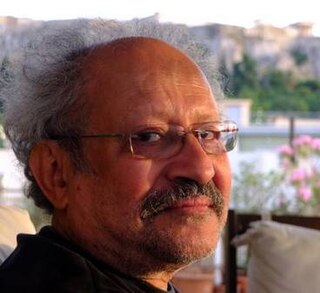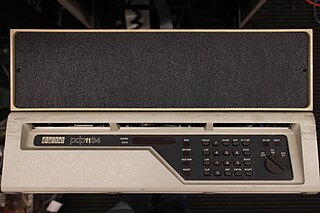Related Research Articles
Computer music is the application of computing technology in music composition, to help human composers create new music or to have computers independently create music, such as with algorithmic composition programs. It includes the theory and application of new and existing computer software technologies and basic aspects of music, such as sound synthesis, digital signal processing, sound design, sonic diffusion, acoustics, electrical engineering, and psychoacoustics. The field of computer music can trace its roots back to the origins of electronic music, and the first experiments and innovations with electronic instruments at the turn of the 20th century.
Electronic music broadly is a group of music genres that employ electronic musical instruments, circuitry-based music technology and software, or general-purpose electronics in its creation. It includes both music made using electronic and electromechanical means. Pure electronic instruments depended entirely on circuitry-based sound generation, for instance using devices such as an electronic oscillator, theremin, or synthesizer. Electromechanical instruments can have mechanical parts such as strings, hammers, and electric elements including magnetic pickups, power amplifiers and loudspeakers. Such electromechanical devices include the telharmonium, Hammond organ, electric piano and electric guitar.
Granular synthesis is a sound synthesis method that operates on the microsound time scale.

Clarence Albertson Barlow was a British composer of classical and electroacoustic works. He was an academic teacher internationally, at the Royal Conservatory of The Hague from 1990 and at the University of California, Santa Barbara, from 2006, among others. He taught at the Darmstädter Ferienkurse from 1982 to 1994.
Electroacoustic music is a genre of popular and Western art music in which composers use technology to manipulate the timbres of acoustic sounds, sometimes by using audio signal processing, such as reverb or harmonizing, on acoustical instruments. It originated around the middle of the 20th century, following the incorporation of electric sound production into compositional practice. The initial developments in electroacoustic music composition to fixed media during the 20th century are associated with the activities of the Groupe de recherches musicales at the ORTF in Paris, the home of musique concrète, the Studio for Electronic Music in Cologne, where the focus was on the composition of elektronische Musik, and the Columbia-Princeton Electronic Music Center in New York City, where tape music, electronic music, and computer music were all explored. Practical electronic music instruments began to appear in the early 20th century.

Max Vernon Mathews was an American pioneer of computer music.
Horacio Vaggione is an Argentinian composer of electroacoustic and instrumental music who specializes in micromontage, granular synthesis, and microsound and whose pieces are often scored for performers and computers.
Wayne Siegel is an American composer living in Malling, Denmark.

Eduardo Reck Miranda is a Brazilian composer of chamber and electroacoustic pieces but is most notable in the United Kingdom for his scientific research into computer music, particularly in the field of human-machine interfaces where brain waves will replace keyboards and voice commands to permit the disabled to express themselves musically.
Maggi Payne is an American composer, flutist, video artist, recording engineer/editor, and historical remastering engineer who creates electroacoustic, instrumental, vocal works, and works involving visuals.
Scott Wilson is a Canadian composer. He studied music and composition in Canada, the U.S., and Germany, and his teachers include Barry Truax, Wolfgang Rihm, Christos Hatzis, Gary Kulesha, Ron Kuivila, Alvin Lucier, Owen Underhill, Neely Bruce and David Gordon Duke. Since 2004 he has lived in Birmingham, UK, where he is Reader in Electronic Music and Director of Birmingham ElectroAcoustic Sound Theatre and the Electroacoustic Studios at the University of Birmingham.
Christopher Yavelow, the son of a film professor and visual artist, is a composer and proponent of computer assisted composition.
Live electronic music is a form of music that can include traditional electronic sound-generating devices, modified electric musical instruments, hacked sound generating technologies, and computers. Initially the practice developed in reaction to sound-based composition for fixed media such as musique concrète, electronic music and early computer music. Musical improvisation often plays a large role in the performance of this music. The timbres of various sounds may be transformed extensively using devices such as amplifiers, filters, ring modulators and other forms of circuitry. Real-time generation and manipulation of audio using live coding is now commonplace.
Leigh Landy is a composer and musicologist of Dutch and American citizenship. He holds a Research Chair at De Montfort University where he directs the Music, Technology and Innovation Research Centre.
Richard Karpen is an American composer of electronic and acoustic music. He is also known for developing computer applications for music and composition.
Gareth Loy is an American author, composer, musician and mathematician. Loy is the author of the two volume series about the intersection of music and mathematics titled Musimathics. Loy was an early practitioner of music synthesis at Stanford, and wrote the first software compiler for the Systems Concepts Digital Synthesizer. More recently, Loy has published the freeware music programming language Musimat, designed specifically for subjects covered in Musimathics, available as a free download. Although Musimathics was first published in 2006 and 2007, the series continues to evolve with updates by the author and publishers. The texts are being used in numerous mathematics and music classes at both the graduate and undergraduate level, with more current reviews noting that the originally targeted academic distribution is now reaching a much wider audience. Music synthesis pioneer Max Mathews stated that Loy's books are a "guided tour-de-force of the mathematics of physics and music... Loy has always been a brilliantly clear writer. In Musimathics, he is also an encyclopedic writer. He covers everything needed to understand existing music and musical instruments, or to create new music or new instruments. Loy's book and John R. Pierce's famous The Science of Musical Sound belong on everyone's bookshelf, and the rest of the shelf can be empty." John Chowning states, in regard to Nekyia and the Samson Box, "After completing the software, Loy composed Nekyia, a beautiful and powerful composition in four channels that fully exploited the capabilities of the Samson Box. As an integral part of the community, Loy has paid back many times over all that he learned, by conceiving the (Samson) system with maximal generality such that it could be used for research projects in psychoacoustics as well as for hundreds of compositions by a host of composers having diverse compositional strategies."
Beverly Grigsby was an American composer, musicologist and electronic/computer music pioneer.
Marc Battier is a French composer and musicologist.
Mortuos Plango, Vivos Voco for eight-track tape is a musical composition created in 1980 by Jonathan Harvey, with the assistance of Stanley Haynes and Xavier Rodet, commissioned by the Centre Georges Pompidou in Paris. The two sounds contrasted are the tenor bell at Winchester Cathedral, England and the voice of the composer's son Dominic, at the time a chorister there, both recorded by John Whiting. The text is taken from that written on the bell: Horas Avolantes Numero, Mortuos Plango: Vivos ad Preces Voco. Music V was used to analyze and transform the sounds.

nscor is a 1980 electronic composition by Curtis Roads. The piece is built upon multiple synthesis methods and was composed at different studios during a period of five years. It was included on the 1986 compilation album New Computer Music released by WERGO, and the inclusion of the piece on the album was generally positively received by critics.
References
- ↑ accessed July 21, 2015.
- 1 2 3 4 5 6 7 "MAT: Faculty and Researchers Archived 2009-07-09 at the Wayback Machine ", Mat.UCSB.edu.
- ↑ "Synthèse 96: The 26th International Festival of Electroacoustic Music", p.91. Michael Voyne Thrall. Computer Music Journal, Vol. 21, No. 2 (Summer, 1997), pp. 90–92.

